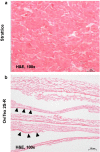Comparison of mechanical properties and host tissue response to OviTex™ and Strattice™ surgical meshes
- PMID: 37031315
- PMCID: PMC10374700
- DOI: 10.1007/s10029-023-02769-0
Comparison of mechanical properties and host tissue response to OviTex™ and Strattice™ surgical meshes
Abstract
Purpose: This study compared the in vitro/benchtop and in vivo mechanical properties and host biologic response to ovine rumen-derived/polymer mesh hybrid OviTex™ with porcine-derived acellular dermal matrix Strattice™ Firm.
Methods: OviTex 2S Resorbable (OviTex 2S-R) and Strattice morphology were examined in vitro using histology and scanning electron microscopy; mechanical properties were assessed via tensile test; in vivo host biologic response and explant mechanics were evaluated in a rodent subcutaneous model. Separately, OviTex 1S Permanent (OviTex 1S-P) and Strattice were evaluated in a primate abdominal wall repair model.
Results: OviTex 2S-R demonstrated layer separation, whereas Strattice retained its structural integrity and demonstrated higher maximum load than OviTex 2S-R out-of-package (124.8 ± 11.1 N/cm vs 37.9 ± 5.5 N/cm, p < 0.001), 24 h (55.7 ± 7.4 N/cm vs 5.6 ± 3.8 N/cm, p < 0.001), 48 h (45.3 ± 14.8 N/cm vs 2.8 ± 2.6 N/cm, p = 0.003), and 72 h (29.2 ± 10.5 N/cm vs 3.2 ± 3.1 N/cm, p = 0.006) following collagenase digestion. In rodents, inflammatory cell infiltration was observed between OviTex 2S-R layers, while Strattice induced a minimal inflammatory response. Strattice retained higher maximum load at 3 (46.3 ± 27.4 N/cm vs 9.5 ± 3.2 N/cm, p = 0.041) and 6 weeks (28.6 ± 14.1 N/cm vs 7.0 ± 3.0 N/cm, p = 0.029). In primates, OviTex 1S-P exhibited loss of composite mesh integrity whereas Strattice integrated into host tissue with minimal inflammation and retained higher maximum load at 1 month than OviTex 1S-P (66.8 ± 43.4 N/cm vs 9.6 ± 4.4 N/cm; p = 0.151).
Conclusions: Strattice retained greater mechanical strength as shown by lower susceptibility to collagenase degradation than OviTex 2S-R in vitro, as well as higher maximum load and improved host biologic response than OviTex 2S-R in rodents and OviTex 1S-P in primates.
Keywords: Acellular dermal matrix; Biologic mesh; Hernia; Hybrid mesh; Primates; Rodents.
© 2023. The Author(s).
Conflict of interest statement
Jared Lombardi, Eric Stec, Marianne Edwards, Talia Connell, and Maryellen Sandor are employees of AbbVie and may hold AbbVie stock.
Figures







Comment in
-
Comment to: Comparison of mechanical properties and host tissue response to OviTex™ and Strattice™ surgical meshes.Hernia. 2024 Feb;28(1):279-280. doi: 10.1007/s10029-023-02822-y. Epub 2023 Jun 23. Hernia. 2024. PMID: 37351711 Free PMC article. No abstract available.
Similar articles
-
Comparison of mechanical properties and host tissue response to OviTex™ and Strattice™ surgical meshes: author reply.Hernia. 2024 Feb;28(1):281-282. doi: 10.1007/s10029-023-02911-y. Epub 2023 Oct 19. Hernia. 2024. PMID: 37855939 Free PMC article. No abstract available.
-
Acellular Dermal Matrix Susceptibility to Collagen Digestion: Effect on Mechanics and Host Response.Tissue Eng Part A. 2023 May;29(9-10):269-281. doi: 10.1089/ten.TEA.2022.0155. Epub 2023 Mar 16. Tissue Eng Part A. 2023. PMID: 36641639
-
A Comparison of Ovine-Reinforced Hybrid Mesh (OviTex PRS) With Porcine Acellular Dermal Matrix (STRATTICE) in the Treatment of Advanced Breast Implant Capsular Contracture.Aesthet Surg J Open Forum. 2024 Aug 20;6:ojae068. doi: 10.1093/asjof/ojae068. eCollection 2024. Aesthet Surg J Open Forum. 2024. PMID: 39421584 Free PMC article.
-
Porcine acellular dermal matrix (PADM) vascularises after exposure in open necrotic wounds seen after complex hernia repair.Int Wound J. 2016 Oct;13(5):972-6. doi: 10.1111/iwj.12558. Epub 2015 Dec 21. Int Wound J. 2016. PMID: 26688300 Free PMC article. Review.
-
Resorbable Synthetic Meshes for Abdominal Wall Defects in Preclinical Setting: A Literature Review.J Surg Res. 2019 May;237:67-75. doi: 10.1016/j.jss.2018.11.054. Epub 2019 Jan 30. J Surg Res. 2019. PMID: 30710881
Cited by
-
Comment to: Comparison of mechanical properties and host tissue response to OviTex™ and Strattice™ surgical meshes.Hernia. 2024 Feb;28(1):279-280. doi: 10.1007/s10029-023-02822-y. Epub 2023 Jun 23. Hernia. 2024. PMID: 37351711 Free PMC article. No abstract available.
-
Handling and Associated Material Properties of Porcine and Human Acellular Dermal Matrices.Aesthet Surg J Open Forum. 2025 Jul 2;7:ojaf083. doi: 10.1093/asjof/ojaf083. eCollection 2025. Aesthet Surg J Open Forum. 2025. PMID: 40800041 Free PMC article.
-
Comparison of mechanical properties and host tissue response to OviTex™ and Strattice™ surgical meshes: author reply.Hernia. 2024 Feb;28(1):281-282. doi: 10.1007/s10029-023-02911-y. Epub 2023 Oct 19. Hernia. 2024. PMID: 37855939 Free PMC article. No abstract available.
-
Collagen Remodeling of Strattice™ Firm in a Nonhuman Primate Model of Abdominal Wall Repair.Bioengineering (Basel). 2025 Jul 24;12(8):796. doi: 10.3390/bioengineering12080796. Bioengineering (Basel). 2025. PMID: 40868309 Free PMC article.
-
Complex Abdominal Wall Reconstruction Involving Large Bridging Mesh at Organ Transplant Incision Site.Plast Reconstr Surg Glob Open. 2025 Mar 24;13(3):e6663. doi: 10.1097/GOX.0000000000006663. eCollection 2025 Mar. Plast Reconstr Surg Glob Open. 2025. PMID: 40129623 Free PMC article.
References
-
- Wang See C, Kim T, Zhu D. Hernia mesh and hernia repair: a review. Engin Regen. 2020;1:19–33. doi: 10.1016/j.engreg.2020.05.002. - DOI
-
- Alimi Y, Merle C, Sosin M, Mahan M, Bhanot P. Mesh and plane selection: a summary of options and outcomes. Plast Aesthet Res. 2020;7:5. doi: 10.20517/2347-9264.2019.39. - DOI
Publication types
MeSH terms
Substances
LinkOut - more resources
Full Text Sources

